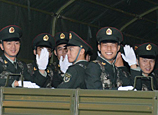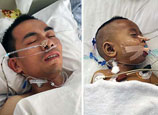
 |
| Wu Run, a 6-year-old girl from a poor family, buries herself among garbage at a residential community in Guiyang, Guizhou province, on Feb 25. Wu Dongjun / for China Daily |
Children in poor areas are benefiting from pilot projects to improve education and healthcare, as set out in the country's 10-year poverty-alleviation strategy, top officials said at a seminar on Tuesday.
A year into the State Council's China Rural Poverty Alleviation and Development Program (2011-20), which pledged that all levels of government will prioritize child development, work has already started to address key issues, particularly nutrition.
According to Liu Shuwen, deputy director of international cooperation for the State Council's Poverty Alleviation Leading Group Office, authorities now provide lunch subsidies for more than 26 million rural primary and junior high school students in 680 impoverished counties.
This year also saw 100 counties start providing free nutrition supplements for children aged 6 months to 2 years, he said in a speech to delegates at an international symposium in Beijing on child poverty jointly held by the State Council, the United Nations Children's Fund and the Australian Agency for International Development.
Although gaps remain, further efforts are ongoing to address the issues, he said.
The government's 10-year blueprint set specific goals to boost child development, including ensuring all rural children have access to preschool education by 2020 and gradually improving healthcare services and financial assistance for children suffering from major diseases.
"Promoting children's development is a vital component of China's strategy to eliminate poverty in rural areas," Fan Xiaojian, director of the State Council's Poverty Alleviation Leading Group Office, said in a speech at the symposium, attended by about 200 experts and government officials from 20 countries in Asia, Africa and Latin America.















 Landmark building should respect the public's feeling
Landmark building should respect the public's feeling


![]()
